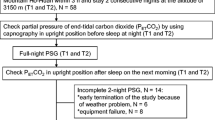Abstract
Sleep disorders at high altitude are common and well-known for centuries. One symptom of the complex is periodic breathing (PB). PB occurs from a disbalance of the negative feedback loop of ventilation control, and at high altitude, it is increased by a phase shift of 180° between hyperventilation and hypoxia. This paper explains the mechanisms that trigger the problem and discusses whether PB may be of advantage or disadvantage for the person going to high altitude. Up to about 3,000–3,500 m, PB may be of advantage because it stabilizes oxygen saturation at a relatively high level. At higher altitudes, disadvantages predominate because frequent arousals cause total sleep deprivation and mental and physical impairment of the victim. Correct acclimatization and “defensive” altitude profiles are gold standard, which minimize PB and optimizes recreative sleep, although they cannot mask PB completely, especially at extreme altitude.





Similar content being viewed by others
References
Hackett P (1991) The Lake Louise Consensus on the definition and quantification of altitude illness. In: Sutton J, Coates G, Houston C (eds) Advances in the biosciences vol. 84: hypoxia and mountain medicine. Proceedings of the 7th International Hypoxia Symposium, Lake Louise, Canada. Pergamon, Oxford, pp 327–330
Eichenberger U, Weiss E, Riemann D et al (1996) Nocturnal periodic breathing and the development of acute high altitude illness. Am J Respir Crit Care Med 154(6 Pt 1):1748–1754
Lakshminarayan S, Pierson DJ (1975) Recurrent high altitude pulmonary edema with blunted chemosensitivity. Am Rev Respir Dis 111(6):869–872
Gilbert DL (1983) The first documented description of mountain sickness: the Andean or Pariacaca story. Respir Physiol 52(3):327–347
Gilbert DL (1991) The Pariacaca or Tullujuto story: political realism. Respir Physiol 86(2):147–157
Bonavia D, Leon-Velarde F, Monge C et al (1985) Acute mountain sickness: critical appraisal of the Pariacaca story and on-site study. Respir Physiol 62(1):125–134
Houston CS (1992) Mountain sickness. Sci Am 267(4):58–62, 66
Houston CS (1993) Tell me stories about yesterday. J Wild Med 4:14–16
Hultgren HN (1997) High altitude medicine. Hultgren, Stanford, pp 448–469
Bert P (1878) La pression barométrique. Paris
Mosso A (1899) Der Mensch auf den Hochalpen. Leipzig
Zuntz N, Loewy A, Müller F et al (1906) Höhenklima und Bergwanderungen in ihrer Wirkung auf den Menschen. Deutsches Verlagshaus Bong, Berlin
Frates RC Jr, Harrison GM, Edwards GA (1977) High-altitude pulmonary edema in children. Am J Dis Child 131(6):687–689
Hultgren HN, Marticorena EA (1978) High altitude pulmonary edema. Epidemiologic observations in Peru. Chest 74(4):372–376
Marugg D (1995) Lungenprobleme bei akuter bis subakuter Exposition in mittleren Höhen. Schweiz Rundsch Med Prax 84(40):1101–1107
Moore LG, Niermeyer S, Zamudio S (1998) Human adaptation to high altitude: regional and life-cycle perspectives. Am J Phys Anthropol 27(Suppl):25–64
Anholm JD, Powles AC, Downey R 3rd et al (1992) Operation Everest II: arterial oxygen saturation and sleep at extreme simulated altitude. Am Rev Respir Dis 145(4 Pt 1):817–826
Wickramasinghe H, Anholm JD (1999) Sleep and breathing at high altitude. Sleep Breath 3(3):89–102
Mizuno K, Asano K, Okudaira N (1993) Sleep and respiration under acute hypobaric hypoxia. Jpn J Physiol 43(2):161–175
Khoo MC, Anholm JD, Ko SW et al (1996) Dynamics of periodic breathing and arousal during sleep at extreme altitude. Respir Physiol 103(1):33–43
Kinsman TA, Townsend NE, Gore CJ et al (2005) Sleep disturbance at simulated altitude indicated by stratified respiratory disturbance index but not hypoxic ventilatory response. Eur J Appl Physiol 94(5–6):569–575
Zielinski J, Koziej M, Mankowski M et al (2000) The quality of sleep and periodic breathing in healthy subjects at an altitude of 3,200 m. High Alt Med Biol 1(4):331–336
Salvaggio A, Insalaco G, Marrone O et al (1998) Effects of high-altitude periodic breathing on sleep and arterial oxyhaemoglobin saturation. Eur Respir J 12(2):408–413
Koziej M, Mankowski M, Sarybaev AS et al (1996) Quality of sleep and periodic breathing during sleep in healthy persons at a height of 3200 meters. Pneumonol Alergol Pol 64(9–10):651–657
Basnyat B, Gertsch JH, Johnson EW et al (2003) Efficacy of low-dose acetazolamid (125 mg BID) for the prophylaxis of acute mountain sickness: a prospective, double-blind, randomized, placebo-controlled trial. High Alt Med Biol 4(1):45–52
Netzer N, Hoefer M, Steinacker J et al (1999) Theophyllin reduces periodic breathing during sleep at high altitude. In Proceedings of the International Hypoxia Symposium. Jasper, Alberta, Canada
Fischer R, Lang SM, Steiner U et al (2000) Theophyllin improves acute mountain sickness. Eur Respir J 15(1):123–127
Fischer R, Lang SM, Leitl M et al (2004) Theophyllin and acetazolamid reduce sleep-disordered breathing at high altitude. Eur Respir J 23(1):47–52
Acknowledgments
The manuscript bases on a lecture held at the 2nd International Hypoxia Symposium, Bad Reichenhall/Germany in January 2007. Thanks to the Academy for Mountains and Health, especially Nik Netzer, Assist. Prof., MD, for the perfect organization of the meeting. A warm “Thank you” as well to the colleagues J. Steffgen, M. Hoefer, and U. Gieseler for their long-lasting cooperation and their fantastic companionship in the mountains!
Author information
Authors and Affiliations
Corresponding author
Rights and permissions
About this article
Cite this article
Küpper, T., Schöffl, V. & Netzer, N. Cheyne stokes breathing at high altitude: a helpful response or a troublemaker?. Sleep Breath 12, 123–127 (2008). https://doi.org/10.1007/s11325-007-0155-5
Published:
Issue Date:
DOI: https://doi.org/10.1007/s11325-007-0155-5




